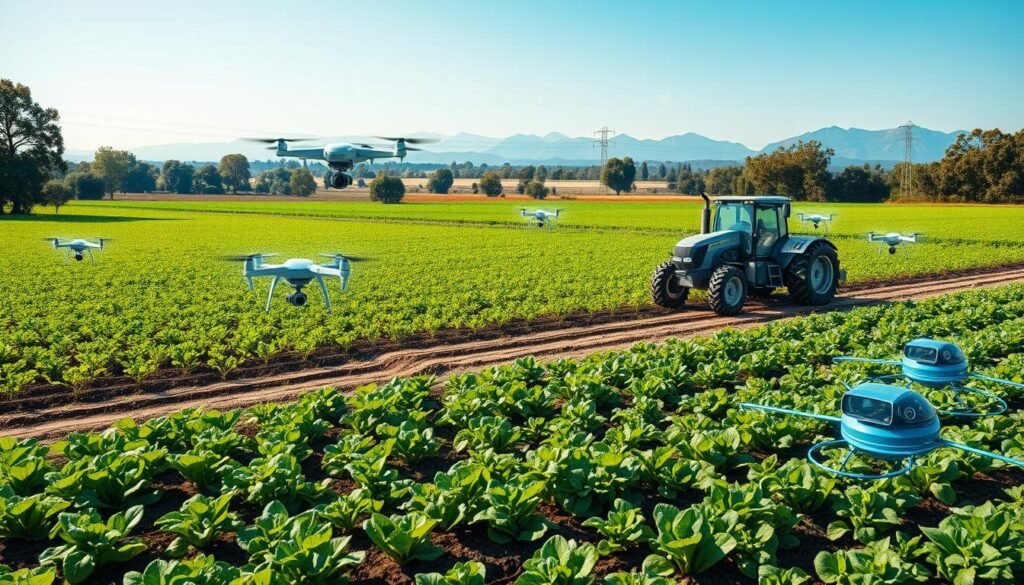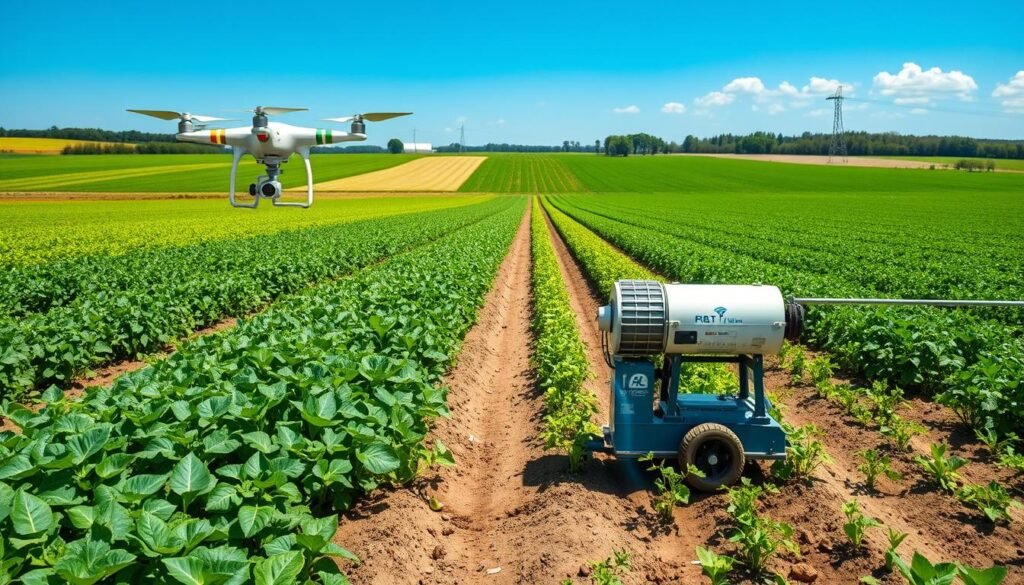Did you know only 27 percent of U.S. farms or ranches use precision agriculture? This shows we need a big change in farming1. With more people needing food, using Artificial Intelligence in Agriculture is key. It's making farming smarter and more sustainable2.
By using data and automated tools, farmers can work better, grow more, and save resources2. These tools help with water, pests, and crops. They make farming stronger3. It's time to see how AI can change farming and solve food production problems.
Key Takeaways
- Only 27% of U.S. farms currently use precision agriculture techniques1.
- AI technologies can potentially increase crop yields significantly while reducing input costs3.
- Implementation of AI tools can lead to more sustainable farming practices by minimizing chemical usage and runoff1.
- Incorporating AI can provide a comprehensive analysis of weather patterns and crop health2.
- Financial assistance and support programs exist to help farmers transition to AI-driven agriculture1.
The Rise of Precision Agriculture
The world's population is expected to hit 10 billion by 2050. This puts a lot of pressure on farming. Traditional farming can't keep up with the demand for food and the need for sustainability. Precision Agriculture is a key solution to boost crop yields and use resources wisely.
Understanding Precision Farming Techniques
Precision farming uses advanced tech like Variable Rate Technology (VRT) and Remote Sensing Technologies (RST). These tools help farmers manage their fields better. They make sure water and fertilizer are used right.
AI in farming helps too. It can spot pests with over 90% accuracy. Drones help apply pesticides precisely, saving money and reducing waste4.
Global Food Demands and Sustainability Challenges
Sustainable farming is more important than ever. Precision Agriculture helps grow more food without using more land. It also saves resources by using them better.
AI helps farmers manage water, predict weather, and find diseases early. This leads to better crops4. The smart farming market is expected to grow a lot by 2027. This shows how important tech is in farming4.
Artificial Intelligence in Agriculture: A Game Changer
Using Artificial Intelligence in Agriculture changes how you farm. It helps solve big problems and boosts your farm's output. With AI, you can grow crops better and care for the planet at the same time.
Integrating AI with Traditional Farming Practices
AI is making farming better in many ways. It helps with watering, fighting pests, and watching over crops. For example, machines can work faster and more accurately than people.
By using precision farming solutions, you can check soil moisture and adjust water use. This saves water and cuts down on waste5. AI can also spot diseases like apple black rot with great accuracy5.
With the world's population set to hit 10 billion by 2050, we need these new tools6.
Benefits of AI Implementations for Farmers
The benefits of AI implementations are huge. They give farmers like you important data for better choices and more crops. AI helps use resources like water and fertilizers wisely5.
As AI in farming grows, with a market size expected to hit USD 4.7 billion by 2028, it's smart to invest6. AI lets you analyze data better, making farming smoother and forecasting markets better6.
AI in Smart Agriculture: Tools for Precision Farming
Farming is changing fast, and Essential Technologies are key for Smart Agriculture. Drones, IoT sensors, and GPS help farmers work better. These tools use AI to make smarter choices.
Essential Technologies Driving Precision Agriculture
Precision farming uses AI to manage fields better, boosting crop yields and cutting waste7. Drones with sensors check crop health and spot pests. IoT sensors track soil moisture and nutrients for better watering and fertilizing7.
GPS and GNSS help plant crops at the right depth and spacing. This leads to higher yields7.
Enhancing Decision-Making through AI Analytics
AI analytics is vital for better farming plans. It predicts yields with advanced algorithms and data from many sources7. Predictive analytics use stats and machine learning to forecast yields, helping plan resources better7.
AI also spots plant diseases with image recognition. This gives farmers crucial time to act. Such efforts can raise crop yields by 20% and cut greenhouse gas emissions8.
| Technology | Key Benefits | Impact on Yields |
|---|---|---|
| Drones | Crop health monitoring, pest detection | Increased yield potential |
| IoT Sensors | Real-time soil condition measurements | Improved irrigation and fertilization |
| GPS Technology | Optimal planting practices | Maximized crop yield |
| AI Analytics | Enhanced decision-making | 20% potential increase in crop yields |
“Smart farms have demonstrated significant efficiency, using up to 95% less water than traditional methods.”
Advanced Farming Techniques Utilizing AI
Agriculture is changing fast with the help of AI. Automated irrigation systems are a big part of this change. They use real-time soil moisture levels to decide when to water crops.
By using automated irrigation systems, you can save a lot of water. This makes your farm more efficient and helps the environment.
Automated Irrigation Systems and Their Impact
These systems also save money by reducing the need for manual watering. With the weather always changing, it's crucial to water crops just right. Sensors send data to a central hub, helping farmers make quick decisions.
Studies show farmers can grow up to 15% more crops with these systems. They also use about 20% less water than old methods. This shows how important advanced technologies are for farming9.
Crop Monitoring with Drones and Satellite Data
Drones and satellite data also help a lot with crop monitoring. Drones give you a bird's eye view of your fields. This helps spot problems like pests and nutrient issues10.
Remote sensing lets you check on crop health and moisture levels. This info helps you make better decisions about growing crops and controlling pests. Using these advanced farming techniques boosts productivity and supports sustainable farming.
Together, automated irrigation and drone technology make farming more efficient. These tools are key to improving farming for the future.
Data Analytics: The Backbone of Smart Farming
Data analytics is key to Smart Farming, giving farmers valuable insights through real-time data collection. It helps optimize farming by ensuring crops get the right resources at the right time. IoT devices collect data constantly, helping farmers monitor soil and crops better.
Real-time Data Collection and Insights
Collecting data in real-time is crucial for better farming. IoT devices provide ongoing updates on soil moisture and weather. This data helps farmers make smarter choices, leading to higher yields and less waste. Studies show precision agriculture can increase yields by 30% and cut water use by 50%11.
Predictive Analytics for Yield Optimization
Predictive analytics helps farmers predict outcomes and make timely decisions. By analyzing past data, farmers can forecast crop yields and adjust their plans. Advanced algorithms can even help plan planting and harvesting better. Data analytics can reduce farming risks by 30%12.
Resource Management Solutions through Data
Data-driven strategies are essential for managing resources in farming. Smart farming uses technology to reduce waste and promote sustainability. Data insights help farmers use inputs more efficiently, boosting profits. Precision agriculture cuts costs and improves the environment, supporting sustainable farming13.
| Technology | Impact | Benefits |
|---|---|---|
| IoT Devices | Real-time Data Collection | Continuous monitoring and reporting |
| Predictive Analytics | Yield Forecasting | Informed decision-making |
| Data Analytics | Resource Optimization | Reduced waste and improved sustainability |
In conclusion, using data analytics in Smart Farming offers big benefits. These innovations keep farming competitive, efficient, and sustainable for the future111312.
AI-Driven Agriculture Innovations
AI is changing farming, especially in soil management and pest control. These new technologies help farmers make better choices. They also improve farm productivity.
Emerging AI Tools in Soil Management
AI in farming gives farmers detailed soil health data. This helps them manage soil better. For example, AI uses satellite images and sensors to apply water and fertilizers precisely.
This method cuts down waste and boosts crop yields by up to 30%. It also saves water by 20-50%14. AI checks soil moisture, temperature, and nutrients for better irrigation and fertilization. This makes farming more sustainable15.
AI Applications for Disease and Pest Control
AI is also changing how farmers fight diseases and pests. It uses computer vision to spot plant diseases early. This means farmers can act fast and use fewer chemicals15.
AI also helps with pest management. It makes disease identification more precise. This leads to better decision-making and less harm from pests14. Drones with AI do aerial imaging for crop analysis. This ensures crops are healthy and well-managed.
These tools are getting better, promising a smart and efficient future for farming16.
Precision Agriculture Technologies: Key Components
In today's farming world, Precision Agriculture Technologies are changing how we farm. They use GPS and IoT to help farmers work smarter. This leads to better crops and a healthier planet.
Utilizing GPS and IoT for Smart Agriculture
GPS has been key in precision farming since the 1990s. It helps farmers place seeds and apply fertilizers and pesticides with great accuracy. This way, they can grow more and waste less.
With IoT, farmers can now monitor soil, weather, and crops in real-time. This lets them act fast when needed. Wireless sensors help collect data on soil moisture and fertility.
| Technology | Application | Benefits |
|---|---|---|
| GPS | Field mapping, crop treatment planning | Enhances accuracy, reduces resource waste |
| IoT | Real-time data monitoring | Improves decision-making, increases operational efficiency |
| Wireless Sensors | Soil and crop health monitoring | Enables precise interventions |
GPS and IoT together make farming better and more profitable. They help protect the environment too. As these technologies get better, they will lead to more efficient farming. This will help feed the world's growing population.
Impact of AI on Resource Conservation
Global agriculture is under pressure to use resources better. Artificial intelligence (AI) is a key player in this effort. It's changing farming, especially in how we use water and fertilizers.
How AI Minimizes Environmental Impact
Agriculture uses 69% of the world's freshwater, a fact from the United Nations17. AI helps by making farming more efficient. For example, smart irrigation systems cut down on water waste and help crops grow better.
In Australia, the COALA project saw a 20% better use of irrigation17. Farmers use drones and satellite images to check on crops and soil. This lets them predict water needs more accurately17.This method reduces harm to the environment and saves water.
Efficient Water and Fertilizer Usage with AI
AI also helps with fertilizer use. It analyzes soil to apply nutrients exactly where they're needed. This stops pollution from runoff and boosts crop yields18.
Cloud-based systems for water management help farmers save money and use water wisely17. These AI tools show how farming can be both productive and sustainable.
Challenges and Solutions in Implementing AI for Agriculture
The agriculture sector is changing fast, and AI is a big part of that. But, there are many barriers to using AI in farming. Knowing these challenges is key to making farming better and more efficient.
Barriers to Adoption of Smart Farming Technologies
AI has a lot to offer for farming, but there are still big hurdles. High costs, lack of tech skills, and poor infrastructure are major issues. For small farmers, these AI adoption barriers make it hard to use new tech like precision farming and predictive analytics19.
Many farmers are also hesitant to try new tech. This makes it even harder for them to adopt new farming methods20.
There's also worry about whether AI will pay off. Farmers need hands-on experience with these new tools. But, in some places, advanced farming tech is rare21.
To solve these problems, we need a big plan. Here are some steps:
- Make AI tools more affordable by increasing funding.
- Offer training and education for farmers to learn new skills.
- Help farmers work together to support each other.
By taking these steps, we can make sure all farmers can use Smart Farming Technologies. This will help farming become more productive and sustainable.
Conclusion
AI in Smart Agriculture is changing Precision Farming in big ways. It brings new solutions to the table for today's food needs. With the world's population set to grow, we need to increase food production by over 70% by 2050.
Technologies like AI and the Internet of Things (IoT) are key. They can help improve crop yields by up to 30% and cut water use by 20-50%22.
The future of farming looks bright with these advancements. Precision farming is already 98.65% accurate, showing the power of data-driven methods23. AI helps farmers make quick decisions, improving productivity and resource use by analyzing soil, weather, and plant health24.
By adapting to changing weather and using new strategies, farming can become more sustainable. This is crucial for our planet's future.
When thinking about using these technologies, remember the initial challenges. High costs and a lack of technical skills are hurdles. But, as digital literacy grows, so will AI's role in farming24.
Using AI in Smart Agriculture is more than just today's gains. It's about building a strong, sustainable farming future for all. It's essential for meeting our society's growing food needs.







